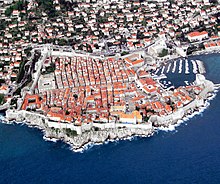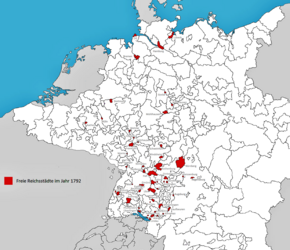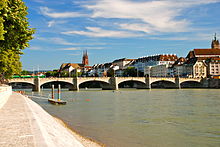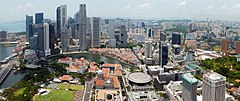City-state
| Part of the Politics series |
| Politics |
|---|
|
|
| Part of the Politics series |
| Basic forms of government |
|---|
| List of countries by system of government |
|
|
A city-state is an independent sovereign city which serves as the center of political, economic, and cultural life over its contiguous territory.[1] They have existed in many parts of the world since the dawn of history, including cities such as Rome, Carthage, Athens and Sparta and the Italian city-states during the Middle Ages and Renaissance, such as Florence, Venice, Genoa and Milan.
With the rise of
Several non-sovereign cities enjoy a high degree of autonomy and are often confused for city-states. Hong Kong, Macau,[4][5] and members of the United Arab Emirates—most notably Dubai and Abu Dhabi—are often cited as such.[6][7][8]
Historical background
Ancient and medieval world

Historical city-states included
In Cyprus, the Phoenician settlement of Kition (in present-day Larnaca) was a city-state that existed from around 800 BC until the end of the 4th century BC.
Some of the most well-known examples of city-state culture in human history are the ancient
Central Europe

In the
After the dissolution of the Holy Roman Empire in 1806, some cities – then members of different
Italy
In Northern and Central Italy during the medieval and Renaissance periods, city-states — with various amounts of associated land — became the standard form of polity. Some of them, despite being de facto independent states, were formally part of the Holy Roman Empire. The era of the Italian states, in particular from the 11th to the 15th centuries, featured remarkable economic development, trade, manufacture, and mercantile capitalism, together with increasing urbanization, with remarkable influence throughout much of the Mediterranean world and Europe as a whole. During this time, most of the Italian city-states were ruled by one person, such as the Signoria or by a dynasty, such as the House of Gonzaga and the House of Sforza.[12]
Examples of Italian city-states during the Middle Ages and the Renaissance
- Republic of Florence, Duchy of Milan, Duchy of Ferrara,[13] San Marino, Duchy of Modena and Reggio, Duchy of Urbino, Duchy of Mantua and the Republic of Lucca.
- The powerful .
Southeast Asia
In the history of
In early Philippine history, the
20th-century cities under international supervision
Danzig
The Free City of Danzig was a semi-
Fiume
After a prolonged period where the city of
Jerusalem
Under the
Memel
The Klaipėda Region or Memel Territory was defined by the
Shanghai
The Shanghai International Settlement (1845–1943) was an international zone with its own legal system, postal service, and currency.
Tangier

The international zone within the city of Tangier, in North Africa was approximately 373 km2 (144 sq mi). It was at first under the joint administration of France, Spain, and the United Kingdom, plus later Portugal, Italy, Belgium, the Netherlands, Sweden, and the United States. The international zone was initially attached to Morocco. It then became a French-Spanish protectorate from 1923 until 29 October 1956, when it was reintegrated into the state of Morocco.
Trieste
The Free Territory of Trieste was an independent territory situated in Central Europe between northern Italy and Yugoslavia, facing the north part of the Adriatic Sea, under direct responsibility of the United Nations Security Council in the aftermath of World War II, from 1947 to 1954. The UN attempted to make the Free Territory of Trieste into a city state, but it never gained real independence and in 1954 its territory was divided between Italy and Yugoslavia.
West Berlin
In the 20th century West Berlin, though lacking sovereignty, functioned from 1948 until 1990 as a state legally not belonging to any other state, but ruled by the Western Allies. They allowed – notwithstanding their overlordship as occupant powers – its internal organisation as one state simultaneously being a city, officially called Berlin (West). Though West Berlin maintained close ties to the West German Federal Republic of Germany, it never legally formed a part of it.
Modern city-states
Monaco
The
Singapore
Singapore is an island city-state in
Vatican City

Until September 1870, the city of
Because he could not travel without effectively acknowledging the authority of the king, Pius IX and his successors each claimed to be a "
The
States with similar characteristics
A number of other small states share many of these characteristics, and are sometimes cited as modern city-states. Luxembourg, Djibouti,[27] Qatar,[28][29] Brunei,[6] Kuwait,[6][28][30] Bahrain,[6][28] and Malta[31][32][33] are each politically and economically centered on a single city; in the cases of Luxembourg, Djibouti and Kuwait, this primate city is so dominant as to give its name to the country. These countries are distinct from true city-states such as Singapore in that they comprise both their primate city (such as Luxembourg City) and a number of peripheral cities and towns (such as Esch-sur-Alzette and ten other towns) with autonomous municipal authorities, and may also include substantial rural areas (such as the sparsely-populated Éislek forest of northern Luxembourg).
Occasionally, microstates with high population densities such as San Marino are cited as city-states, despite lacking a large urban centre.[6][7][34]
Non-sovereign city-states

Some cities or urban areas, while not sovereign states, may nevertheless be constituent states of a federation, or enjoy a high degree of autonomy. As such, they function as "city-states" within the context of the sovereign state to which they belong. Historian Mogens Herman Hansen describes this aspect of self-government as: "The city-state is a self-governing, but not necessarily independent political unit."[6] A city with more limited self-government may be referred to as an independent city.
Some non-sovereign cities which have a high degree of autonomy which have been described as city-states include:
- Spain: Ceuta and Melilla[35]
- China: Hong Kong and Macau[6]
- France: Paris
- Romania: Bucharest
- United Kingdom: Gibraltar[36]

Some cities that are constituent states in a federation, and as such can be accurately described as non-sovereign city-states with a high degree of autonomy include:
- Argentina: Buenos Aires[37]
- Austria: Vienna[38]
- Belgium: Brussels
- Germany: Bremen, Berlin and Hamburg[6]
- Mexico: Mexico City[39]
- Russia: Moscow and Saint Petersburg[40]
- Basel-Stadt[41]
- United Arab Emirates: Dubai, Abu Dhabi[6][7][8]
Proposed city-states
London
The London independence movement seeks a city-state separate from the United Kingdom.[42]
See also
- Charter city
- City network
- Federal district
- Pyu city-states
- Royal free city
- List of fictional city-states in literature
References
- ^ "city-state | Definition, History, & Facts". Encyclopedia Britannica. Archived from the original on 23 November 2018. Retrieved 19 April 2020.
- ^ Brimelow, Ben. "How a tiny city-state became a military powerhouse with the best air force and navy in Southeast Asia". Business Insider. Archived from the original on 8 April 2018. Retrieved 15 October 2020.
- ^ a b c Long, Simon (18 July 2015). "The Singapore exception" (PDF). The Economist. Archived (PDF) from the original on 25 November 2023.
- ^ "City-states never disappeared: Hamburg, Hong Kong, Singapore". Tomorrow.Mag. 6 September 2019. Archived from the original on 24 September 2020. Retrieved 15 October 2020.
- ^ "Capital Facts for Hong Kong". World's Capital Cities. 16 September 2020. Archived from the original on 23 April 2021. Retrieved 15 October 2020.
- ^ a b c d e f g h i Hansen, Mogens. 2000. "Introduction: The Concepts of City-States and City-State Culture." In A Comparative Study of Thirty City-State Cultures, Copenhagen: Copenhagen Polis Centre. Pg. 19
- ^ .
- ^ a b Kotkin, Joel. 2010. "A New Era for the City-State?" In Forbes.
- ISBN 978-0-333-64830-8.
- ^ Holm, Poul, "Viking Dublin and the City-State Concept: Parameters and Significance of the Hiberno-Norse Settlement" (Respondent: Donnchadh Ó Corráin), in Mogens Herman Hansen (ed.), A Comparative Study of Thirty City-State Cultures Archived 21 June 2013 at the Wayback Machine. Denmark: Special-Trykkeriet Viborg. (University of Copenhagen, Polis Center). 2000. pp. 251–62.
- ^ Sri Aurobindo, "Ideal of Human Unity" included in Social and Political Thought, 1970.
- ^ "Italy - Italy in the 14th and 15th centuries". Encyclopedia Britannica. Archived from the original on 25 February 2008. Retrieved 12 May 2021.
- ^
Haney, John (1987). Cesare Borgia. World leaders past & present. New York: Chelsea House. p. 74. ISBN 9780877545958. Retrieved 4 October 2020.
[...] the duchy of Ferrara — a small but strategically important city-state situated between Venice and the Romagna.
- ^
ISBN 9780300156522. Retrieved 8 October 2017.
- ^ Winichakul, Thongchai. 1997. Siam Mapped: A History of the Geo-Body of a Nation. Honolulu: University of Hawaii Press
- ^ Baker, Chris and Pasuk Phongpaichit. 2009. A History of Thailand: 2nd ed. Sydney: Cambridge University Press
- ^ Quezon, Manolo (2 October 2017). "The Explainer: Bamboozled by the barangay". ABS-CBN News. Archived from the original on 2 October 2017. Retrieved 4 October 2017.
- ^ ISBN 978-971-550-347-1.
- ^ Junker, Laura Lee (1990). "The Organization of Intra-Regional and Long-Distance Trade in Pre-Hispanic Philippine Complex Societies". Asian Perspectives. 29 (2): 167–209.
- ISBN 9781134200504. Archivedfrom the original on 4 February 2018. Retrieved 7 May 2018 – via Google Books.
- Nagcarlan, Laguna. Archived from the originalon 23 January 2009.
- ISBN 978-3-406-60587-1. Archivedfrom the original on 30 March 2023. Retrieved 24 May 2020.
- ISBN 3-8258-6284-4. Archivedfrom the original on 30 March 2023. Retrieved 24 May 2020.
- ^ "Environment". Base. Archived from the original on 19 July 2019. Retrieved 21 February 2021.
- ISBN 087413353X.
- ISBN 978-9814663397.
- ^ "Foreign Operations, Export Financing, and Related Programs, Volume 2." Archived 9 April 2023 at the Wayback Machine United States Congress House Committee on Appropriations. Subcommittee on Foreign Operations, Export Financing, and Related Programs. April 15, 1992. Page 239: "The Republic of Djibouti is in effect a city - state, with few natural resources, few trained workers, no permanent streams and very little arable land. Some 75% of the population live in the capital city, the economy of which is focused on the port, airport, railway, the French garrison, and the re-export of consumer goods."
- ^ a b c Parker, Geoffrey. 2005. Sovereign City: The City-state Through History Chicago: University of Chicago Press. p. 219
- ^ Roberts, David. 2014. Qatar: Securing the Global Ambitions of a City-state. London: C Hurst & Co Publishers Ltd.
- ^ El-Katiri, Laura, Bassam Fattouh and Paul Segal. 2011 Anatomy of an oil-based welfare state: rent distribution in Kuwait. Kuwait City: Kuwait Programme on Development, Governance and Globalisation in the Gulf States
- ^ "The emblem of Malta, Department of Information, Official Website of President of Malta". Doi.gov.mt. Archived from the original on 22 October 2013. Retrieved 20 October 2013.
- ^ "Draft National Strategy for the Cultural and Creative Industries – Creative Malta". Creativemalta.gov.mt. Archived from the original on 28 July 2013. Retrieved 20 October 2013.
- ^ "Malta". European Central Bank. Archived from the original on 7 April 2014. Retrieved 7 May 2018.
- ^ Mogens, Hansen. 2002. A Comparative Study of Six City-State Cultures: An Investigation p. 91
- ISBN 9780313320613. Archivedfrom the original on 2 November 2017.
- ^ "Qué dice la Ley Cafiero" (in Spanish). Infobae.com. Archived from the original on 28 March 2012. Retrieved 2 May 2012.
- ^ City of Vienna, "From the Capital of the Austro-Hungarian Empire to the Capital of the Republic - History of Vienna". Archived 14 April 2023 at the Wayback Machine, retrieved 17 May 2010.
- ^ "Constitution of Mexico City" (PDF) (in Spanish). Gobierno de la Ciudad de México. Archived (PDF) from the original on 15 July 2022. Retrieved 8 February 2021.
- ^ Kremlin.ru. Договор между Российской Федерацией и Республикой Крым о принятии в Российскую Федерацию Республики Крым и образовании в составе Российской Федерации новых субъектов Archived 19 March 2015 at the Wayback Machine (Treaty Between the Russian Federation and the Republic of Crimea on Ascension to the Russian Federation of the Republic of Crimea and on Establishment of New Subjects Within the Russian Federation) (in Russian)
- ^ Canton of Basel-Stadt Archived 23 January 2020 at the Wayback Machine Welcome
- ^ "'Londependence' May Be a Dream, but More Autonomy for the City Is Not". The New York Times. 28 June 2016. Archived from the original on 21 March 2017. Retrieved 2 March 2017.
Further reading
- ISBN 87-7876-177-8.
- Mogens Herman Hansen (ed.), A comparative study of six city-state cultures : an investigation, Det Kongelige Danske Videnskabernes Selskab, 2002. (Historisk-filosofiske skrifter, 27). ISBN 87-7876-316-9.
- Geoffrey Parker, Sovereign City: The City-State Ancient and Modern, London: ISBN 978-186189-219-5.
- Tom Scott, The City-State in Europe, 1000-1600: Hinterland, Territory, Region, Oxford: ISBN 978-019173-868-5
External links
 Media related to City-states at Wikimedia Commons
Media related to City-states at Wikimedia Commons


